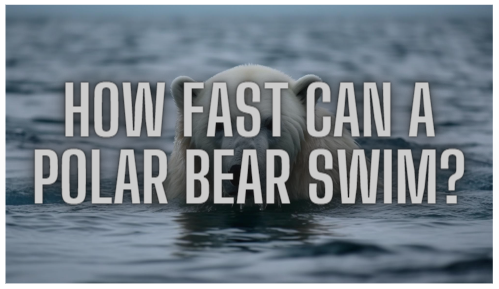A polar bear is a skilled swimmer and can swim at an average speed of around 6 miles per hour (9.7 kilometers per hour) in open water. They use their powerful front limbs to paddle through the water and their hind limbs to steer. This swimming ability allows them to traverse long distances in search of food, mates, or suitable ice habitats. Polar bears are well adapted to their Arctic environment, and their streamlined bodies, dense fur, and thick layer of blubber provide them with insulation and buoyancy while swimming.
How Do Polar Bears Swim Fast?
Polar bears are capable of swimming relatively fast due to several adaptations that allow them to navigate through water efficiently. Here are some factors that contribute to their fast swimming ability:
Streamlined body shape: Polar bears have a streamlined body shape, which minimizes water resistance and drag as they move through the water. Their elongated bodies, tapered heads, and streamlined limbs help reduce friction, allowing them to swim faster.
Powerful front limbs: Polar bears have strong, muscular front limbs that they use to paddle through the water. These limbs provide propulsion and help them maintain speed while swimming. They are capable of powerful strokes, allowing them to generate forward momentum.
Efficient propulsion techniques: Polar bears use a combination of their front limbs and hind limbs to swim. While their front limbs primarily provide propulsion, their hind limbs act as rudders, allowing them to steer and change direction. This coordinated movement helps them swim efficiently and maintain speed.
Buoyancy and insulation: Polar bears have a thick layer of blubber, which provides buoyancy and insulation while swimming. The blubber helps them stay afloat and reduces heat loss in the cold Arctic waters. This insulation allows them to swim comfortably for extended periods, supporting their ability to maintain speed.
Adaptations for cold water: Polar bears have adaptations that enable them to swim in frigid waters. Their fur is water repellent and helps reduce drag. Additionally, their dense fur and layer of blubber provide insulation, keeping them warm in cold water and allowing them to conserve energy while swimming.
Who Can Swim Faster Than A Polar Bear?
Several marine mammals are known to swim faster than polar bears.
Dolphins: Dolphins are incredibly fast swimmers and can reach speeds of up to 20-25 miles per hour (32-40 kilometers per hour). Some dolphin species, such as the common dolphin, are renowned for their agility and speed in the water.
Orcas (Killer Whales): Orcas are apex predators and are known for their speed and power. They can swim at speeds of up to 34.5 miles per hour (56 kilometers per hour). Orcas are considered one of the fastest marine mammals.
Swordfish: Swordfish are known for their exceptional speed and agility in the water. They can swim at speeds of up to 50 miles per hour (80 kilometers per hour). Swordfish have a long, streamlined body and a crescent-shaped tail that helps them achieve impressive swimming speeds.
Marlin: Marlins, particularly the sailfish and the black marlin, are known for their incredible speed and are considered some of the fastest fish in the ocean. They can swim at speeds of up to 60 miles per hour (97 kilometers per hour).
Who Swims Slower Than A Polar Bear?
There are several marine mammals that swim slower than polar bears.
Manatees: Manatees, also known as sea cows, are large, herbivorous marine mammals. They are known for their slow swimming speeds, typically ranging from 3 to 5 miles per hour (5 to 8 kilometers per hour).
Dugongs: Dugongs are closely related to manatees and share similar characteristics. They are also known for their slow swimming speeds, generally ranging from 3 to 6 miles per hour (5 to 9 kilometers per hour).
Sloths: Although not marine mammals, sloths are known for their slow movement both on land and in water. They are excellent swimmers but have a leisurely pace, typically swimming at speeds of around 0.5 miles per hour (0.8 kilometers per hour).
Seals: While seals can swim at moderate speeds, they generally swim slower than polar bears. Their swimming speeds can vary depending on the species, but they typically range from 4 to 12 miles per hour (6 to 19 kilometers per hour).

